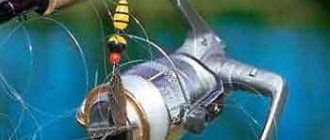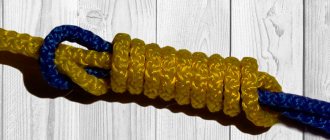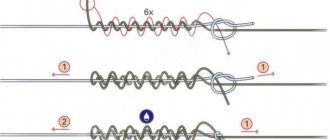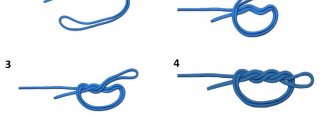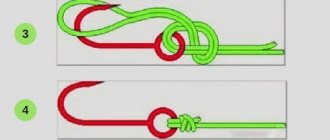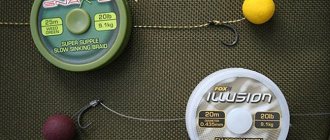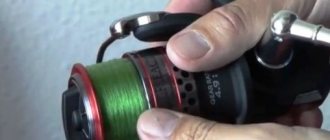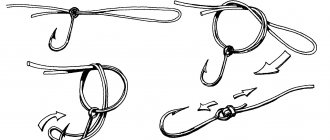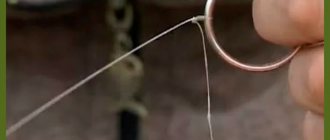Everyone knows how to tie knots. The only question is how we do it. After all, they almost always use a straight knot (or even worse, if it’s a “woman’s” knot). And it’s okay if they are used for domestic purposes, but there are other cases. You are towing a car and the rope has broken - how to tie a good knot so that the rope does not come undone? At the construction site of your house, you need to lift something on a rope - how to tie a rope to a carabiner, bucket handle, etc. And if at the same time there is still no cable of the required length, then you need to correctly tie the ropes together. In a word, there can be many situations where you need to use a really reliable unit, since otherwise it can be simply dangerous. This article, of course, does not describe all the great variety of knots, but you will find the main useful methods of knitting here.
Knots for tying
"Baby" and straight knot
These two knots are very similar in appearance, but when knitting they differ in only one point. Understand this point and never use the “woman’s” knot in critical situations.
"Baby" knot
Straight knot
The straight knot is the simplest. But it tends to tighten tightly under load and “crawl,” especially on hard, wet or ice-covered ropes.
Learning to tie a straight knot correctly
Reef node
This is the same straight knot, only here an additional “bow” is tied to make it easier to untie.
Fisherman's knot
An original way to tie ropes is essentially two simple knots resting on each other. Can be used without fear for ropes of approximately the same thickness. The downside is that it “creeps” under variable load.
First simple node
Second simple knot
We tighten
You can additionally tie control knots so that the knot “creeps” less
Counter knot
This knot can be used to tie ropes of any size, ribbons, as well as ribbon and rope. Holds well and does not come undone.
The white rope is pulled along the path of the green one
Counter figure eight knot
The principle of tying is the same as that of a counter knot, only the basis is not a simple knot, but a “figure eight”. Can be used for cables of different diameters. At the same time, its advantage, like the previous node, is that it “does not crawl.”
White rope - along the path of the green one
Clew knot
This knot can be quickly tied or untied. A positive feature is that it does not damage the cables, because the knot is not tightened. The downside is that it slips on synthetic ropes (fishing line, polypropylene twine), and can also come undone under “jumping” loads. We tighten
You can make control nodes
grapevine knot
The principle of operation is the same as that of a fishing knot. Strongly tightens under load, reliable. Suitable for ropes of the same and different diameters, fishing lines. The first node is readyThe second node is ready
Two knots are pulled together
Hunter's knot
It is best used on soft ropes, nylon threads, and ribbons. Can creep apart with varying traction. Tying it correctly may require a little practice.
Snake knot
You need to tie a fishing line - this knot is best suited. Reliable connection for ropes made of any material. But it’s not very easy to tie, because... It is necessary to pinch the curls while knitting so that they do not unwind.
Don’t forget to leave a “window” in the middle of the knot to let the ends of the rope pass through
We stretch the ends of the rope through the “window”
We tighten
Furrier's knot
A good knot for strong traction. It is easy to untie, despite the property of being very tight. Also suitable for synthetic slippery threads and twines.
Docker node
It is good for tying ropes of different thicknesses, tying a rope to a loop, but is bad because it falls apart under variable loads.
Flat knot
A very interesting knot. It never gets too tight and doesn’t damage the ropes, because... there are no sharp bends. Easy to untie after removing the traction. It is better to first tighten the knot by hand so that when a load is applied it does not twist. When pulling, it “creeps” for a while, but then stabilizes and holds perfectly. Its properties are especially well demonstrated if, after tying a knot, the ends of each rope are attached to the main rope. This knot is indispensable for tying two cables (even steel ones, on which significant force will be applied).
How to tie two ends of a rope. 10 rope knots that will make your life easier
Oak knot
(Fig. 1). Sailors use it only in exceptional cases, when there is a need to very quickly tie two cables together. Although connecting plant cables with an oak knot is quite reliable, it has a serious drawback: a tightly tightened knot is very difficult to untie later, especially if it gets wet. In addition, a cable tied in such a knot has less strength and during operation creates a danger of catching on something during its movement. Its only positive qualities are the speed with which it can be tied and its reliability.
To connect two cables, their ends need to be folded lengthwise together and, 15-20 centimeters from the edges, tie both ends as one whole with a simple knot.
Do not try to tie synthetic cables and fishing line with this knot: it crawls on them.
Rice. 1. Oak knot
Flemish
node (Fig. 2). This is one of the oldest maritime knots, which was used on ships to connect two cables, both thin and thick. In fact, this is the same figure eight, tied at both ends. There are two ways to tie this knot. The first one is shown in the diagram.
First, make a figure eight at the end of one of the cables tied together. Insert the running end of the second cable towards the exit of the running end and repeat the figure “8” tied on the first cable. After this, grab each two ends, left and right, and begin to tighten the knot evenly, trying to maintain its shape. To final tighten the knot, pull the root ends of the cables.
To connect two cables with a Flemish knot using the second method, place the running ends of the cables being connected parallel to each other so that they touch each other approximately along the length of one meter. At this point, tie a figure eight with two cables folded together. In this case, you will have to carry it around and thread it into the loop along with the short running end of one of the cables and the long main one. This is precisely the inconvenience of the second method of tying the Flemish knot.
The connection of two cables with a Flemish knot is considered very strong. This knot, even if tightly tightened, does not damage the cable, and it is relatively easy to untie. In addition, it has excellent quality - it does not slip and holds securely on synthetic fishing line.
Rice. 2. Flemish knot
Tie two ropes together. Sea knots for beginners. Top 5 most useful
Contents of the article (click to view)
How to tie tourist rope knots
A rope is an indispensable thing not only in everyday life, but also on a hike. Its application is quite wide: from a basic device for drying clothes to organizing crossings, insurance and other vital devices.
Therefore, every serious hiker should know how to tie knots on a rope. And not simple ones, but tourist rope knots for all occasions.
Let's consider tourist nodes. They are subject to certain requirements: they must simply tie, not spontaneously untie under load or after its removal, under variable loads, not “crawl” and not tighten “tightly” if this is not necessary. According to their purpose, tourist hubs are divided into:
1. Knots for tying ropes of the same diameter: “straight”, “weaving”, “counter”, “grapevine”.
2. Knots for tying ropes of different diameters: “academic”, “bracket”.
3. Knots for belaying (non-tightening loops): “simple conductor”, “figure eight”, “middle Austrian conductor”, “double conductor”.
Articles on the topic (click to view)
4. Knots for tying ropes to a support: “noose”, “bowline”, “stirrup”.
5. Auxiliary nodes: “grasping”, “stirrup”.
Also, when tying knots, you should remember that each rope has a strength characteristic. The strength of the rope is significantly weakened by knots.
For example, a weaving knot weakens the strength of the rope by 35%, a figure eight knot by 25%, a bowline knot by 30%. Remember, a wet rope loses 10% of its strength, and if you use a rope in 30° below zero, the strength decreases by 30%.
We knit a “straight” knot
Tying a straight knot is very simple, but it is intended for those cases when someone's life does not depend on it. T.
That is, it is not suitable for belaying, because it can come untied and slide off.
Hunter and fisherman with 20 years of experience. Wildlife lover
When tying a straight knot, so-called control fixing knots are required. What's good about this node? It is easy to untie, just pull the two ends of the rope on one side of the knot.
And besides, it knits quickly and easily. T.
e. if you need to quickly tie two ropes of the same diameter for light loads, a straight knot is perfect.
This knot unties itself, so it should only be used with control knots. To tie them, the running ends must be more than 15 cm long. The knot is tied correctly if the running ends come out either only from the bottom or only from the top.
Stirrup knot
The knot can be used as a fulcrum for the leg when climbing out of cracks. It is more convenient than the “guide” and “eight” because it is easier to untie and can be tied even with one hand.
The knot can be used during rescue operations to slow down a rope and tie a stretcher using improvised means. Also used for self-belaying on pitons and for intermediate belaying.
Tourist nodes: guide, guide-eight
How to tie a guide and figure eight knot correctly? The differences when tying them are insignificant. They are designed to create a strong loop, used in a climbing harness.
The conductor and figure eight are very reliable units, which is why they are widely used in tourism. In this case, the figure eight is considered more reliable, and therefore does not require control nodes, unlike a conductor.
It is knitted with one rope, which is folded in half and a simple knot is tied at the end to form a loop. You can also tie it in the middle of the rope.
Hunter and fisherman with 20 years of experience. Wildlife lover
This knot is very simple to perform - practically it is the simplest non-tightening loop. Can be knitted at one end.
Under load it pulls tightly and crawls on a rigid rope. Used to attach a rope loop to something.
To make untying easier after use, you can first insert an object into the weave of the knot. If there is a high probability of variable loads, it is recommended to knit a control knot.
Such a knot leads to a decrease in the strength of the rope by 30-40%.
This node can be considered as a preparatory node before studying the next node - conductor figure eight.
How to take a figure-eight conductor knot? Scheme:
Knitted with one rope. It is a modification of a simple conductor. You should make the loop half a turn more and insert it into the knot on the other side. This knot can also be tied at one end. A control node is not required here. The scope of application of the figure eight conductor knot is similar to a simple conductor.
